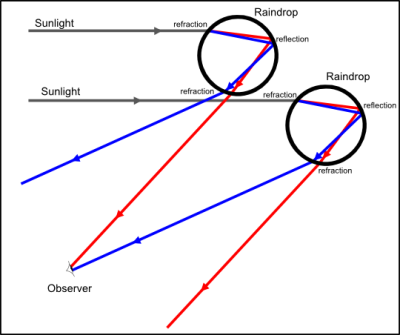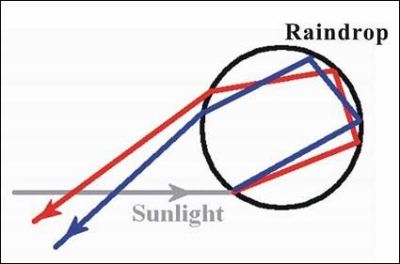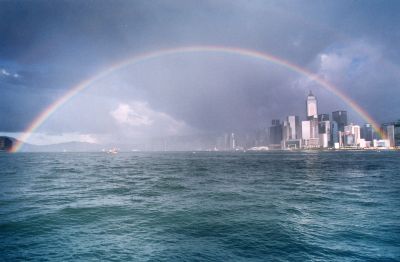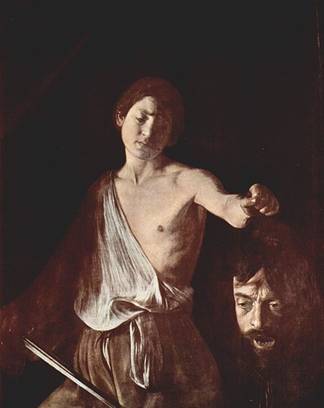Echoes of the rainbow
1 April 2010
The international award-winning movie "Echoes of the rainbow" does not just bring nostalgia to many Hong Kong people. It also includes some science tidbits. In fact, it is one of the rainbow's many interesting characteristics that apparently gives the movie's namesake.
In the movie, it is mentioned that once in a while you can see a double rainbow, and the sequence of colours in the secondary bow is the reverse of the primary.

Figure 1
The diagram below explains the phenomenon of the primary bow. A colour band in the rainbow that we see is formed as a result of reflection and refraction from many raindrops at different places.

Figure 2
A secondary bow is produced when sunlight gets reflected twice inside raindrops. The colours are reversed.

Figure 3
In the photo below, one can notice that the region outside the primary bow is much darker than inside.

Figure 4 - Photo : Wah Kiu Yat Po, 3 August 1993
The interested reader may like to see the explanation in:
http://www.weather.gov.hk/prtver/pdf/docs/education/edu06nature/ele_rainbow_e.pdf
The movie also mentions that fish cannot recognize itself in a mirror. In the animal kingdom, we know that only one species can do this trick --- not your pet dog or cat. If you wish to know more, check the Director's blog article on 21 December 2009.
The director of the movie, Alex Law, said one of the reasons he did the film was that, unlike the older days, people complain too much and there is too much 'negative energy' these days.
In the older days when there were a lot of wooden squatter settlements and make-shift huts, people upon the issuing of typhoon signals had to hurry home to attend to their lodgings. Over the past few decades Hong Kong has witnessed a sea change. One can see no more of these settlements and huts nowadays.
The Chinese name of the movie means 'Time thief'. It reminds me of a painting by the famous Italian Caravaggio (1571-1610), David with the head of Goliath.

Figure 5, courtesy Wikipedia
Done late in Caravaggio's life, the picture shows the boy handling his trophy at the end of his outstretched arm, somewhat with disgust. It was said soon after the painter's death that the two faces in the picture are both of Caravaggio himself, one in his youth and the other as an older man. It was youth contemplating age and mortality.
As Hong Kong people, we do not have to look back at the 1960s and 1970s with such sadness and contempt. Instead, life in that era gives us momentum and resilience.
B.Y. Lee
In the movie, it is mentioned that once in a while you can see a double rainbow, and the sequence of colours in the secondary bow is the reverse of the primary.

Figure 1
The diagram below explains the phenomenon of the primary bow. A colour band in the rainbow that we see is formed as a result of reflection and refraction from many raindrops at different places.

Figure 2
A secondary bow is produced when sunlight gets reflected twice inside raindrops. The colours are reversed.

Figure 3
In the photo below, one can notice that the region outside the primary bow is much darker than inside.

Figure 4 - Photo : Wah Kiu Yat Po, 3 August 1993
The interested reader may like to see the explanation in:
http://www.weather.gov.hk/prtver/pdf/docs/education/edu06nature/ele_rainbow_e.pdf
The movie also mentions that fish cannot recognize itself in a mirror. In the animal kingdom, we know that only one species can do this trick --- not your pet dog or cat. If you wish to know more, check the Director's blog article on 21 December 2009.
The director of the movie, Alex Law, said one of the reasons he did the film was that, unlike the older days, people complain too much and there is too much 'negative energy' these days.
In the older days when there were a lot of wooden squatter settlements and make-shift huts, people upon the issuing of typhoon signals had to hurry home to attend to their lodgings. Over the past few decades Hong Kong has witnessed a sea change. One can see no more of these settlements and huts nowadays.
The Chinese name of the movie means 'Time thief'. It reminds me of a painting by the famous Italian Caravaggio (1571-1610), David with the head of Goliath.

Figure 5, courtesy Wikipedia
Done late in Caravaggio's life, the picture shows the boy handling his trophy at the end of his outstretched arm, somewhat with disgust. It was said soon after the painter's death that the two faces in the picture are both of Caravaggio himself, one in his youth and the other as an older man. It was youth contemplating age and mortality.
As Hong Kong people, we do not have to look back at the 1960s and 1970s with such sadness and contempt. Instead, life in that era gives us momentum and resilience.
B.Y. Lee